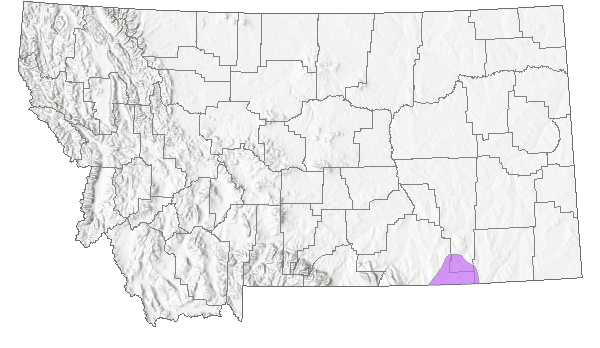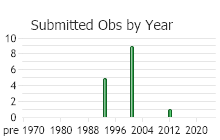View in other NatureServe Network Field Guides
NatureServe
Montana
Utah
Wyoming
Idaho
Wisconsin
British Columbia
South Carolina
Yukon
California
New York
Woolly Twinpod - Physaria didymocarpa var. lanata
Other Names:
Physaria didymocarpa ssp. lanata
State Rank Reason (see State Rank above)
Only a few known occurrences in Montana, including two potentially large populations. However, lots of unsurveyed potential habitat exists. Both BLM and private lands are important to the viability of the species in Montana. Oil and gas development, coalbed methane, and invasive weeds have the potential to detrimentally impact populations.
- Details on Status Ranking and Review
Population Size
Score2-3 - Very Small to Small: Population size is imprecisely known but is believed to be <10,000 individuals.
CommentPopulation estimates are imprecise but available data support a minimum size of at least several hundred plants upwards of a couple thousand plants.
Range Extent
Score2 - Regional or State Endemic or Small Montana Range: Generally restricted to an area <100,000 sq. miles (equivalent to 2/3 the size of Montana or less) or Montana contributes 50% or more of the species’ range or populations OR limited to 2-3 Sub-basins in Montana.
CommentRegional endemic of southeast Montana and adjacent Wyoming
Area of Occupancy
Score2 - Low: Generally occurring in 4-10 Subwatersheds (6th Code HUC’s).
Environmental Specificity
Score1 - Moderate: Species is restricted to a specific habitat that is more widely distributed or to several restricted habitats and is typically dependent upon relatively unaltered, good-quality habitat (C Values of 5-7).
CommentSpecific habitat requirements unclear, though does not appear to be restricted to very narrow conditions, nor to uncommon habitats.
Trends
ScoreNA - Rank factor not assessed.
CommentTrends are unknown.
Threats
Score1-2 - Medium to High.
CommentPotential for negative impacts from oil and gas development and invasive weeds have been identified.
Intrinsic Vulnerability
Score0-1 - Low to Moderate Vulnerability.
CommentDegree of intrinsic rarity uncertain.
Raw Conservation Status Score
Score
8 to 11 total points scored out of a possible 16 (Rarity factors and threats only).
General Description
Woolly Twinpod is a perennial herb with numerous ascending stems that are ca. 1 dm long and arising from a basal rosette surmounting a branched crown and large taproot. The basal leaves are 15-40 mm long and are spoon-shaped with broad-toothed margins and long petioles. The alternate stem leaves are broadly lance-shaped with mostly entire margins. Foliage is covered with silvery, tangled, and spreading hairs. The yellow, stalked flowers are borne at the tops of the stems in a narrow inflorescence that elongates as the fruit matures. Each flower has 4 separate petals that are 9-12 mm long and 4 separate sepals. The ascending, inflated fruits are 7-20 mm tall and at least as wide and are 2-lobed with the lobes more equally defined above and below. There are 4 ovules in each of the 2 chambers. The style is 7-9 mm long.
Phenology
Flowering and fruiting May-June.
Diagnostic Characteristics
There are many similar-appearing
Physaria species; a technical manual and hand lens or microscope will be required for positive identification. The long, tangled spreading hairs on the leaves, especially at the base, help separate this from other species.
Wooly Twinpod -
Physaria didymocarpa var.
lanata, SOC
*Pedicels are spreading, straight to curved, 3-12 mm long.
*Fruits inflated
and obviously 2-lobed, 7-20 mm tall.
*Basal Leaves obovate in shape with entire to coarsely dentate margins.
Sharpleaf twinpod -
Physaria acutifolia*Pedicels are spreading, straight to sigmoid, 5-10 mm long.
*Fruits inflated
and obviously 2-lobed, 6-10 mm wide.
Thick-leaf Bladderpod –
Physaria pachyphylla, SOC
*Inflorescence is a subumbellate raceme.
*Fruiting pedicels curve upwards (ascend), are 3-10 mm long, and less than 2 times longer than fruit.
*Fruits inflated, narrowly elliptic to globose (
not obviously appearing 2-lobed), and 3-6 mm tall. Style is 1-3 mm long, shorter than the mature fruit (silicle).
*Basal leaves have distinct petioles and blades. Basal blades are oblanceolate to orbicular in shape, nearly 1 mm thick, and cupped (
not folded).
*Plants grow on white to pinkish, limestone and gypsum soils on exposed ridges and slopes in the valley zone.
Species Range
Montana Range
Range Descriptions

 Native
Native
Range Comments
Regional endemic of north-central Wyoming and adjacent Montana.
Observations in Montana Natural Heritage Program Database
Number of Observations: 15
(Click on the following maps and charts to see full sized version)
Map Help and Descriptions
Relative Density

Recency



 (Observations spanning multiple months or years are excluded from time charts)
(Observations spanning multiple months or years are excluded from time charts)
Habitat
Sandy, often calcareous soil of open grassland or shrubland slopes in the plains.
National Vegetation Classification System Groups Associated with this Species
Forest and Woodland
Low Elevation - Xeric Forest and Woodland
Grassland
Lowland - Prairie Grassland
Sparse and Barren
Sparse and Barren
Stewardship Responsibility
Threats or Limiting Factors
STATE THREAT SCORE REASON
Threat impact not assigned because threats are not known (MTNHP Threat Assessment 2021).
References
- Literature Cited AboveLegend:
 View Online Publication
View Online Publication MTNHP Threat Assessment. 2021. State Threat Score Assignment and Assessment of Reported Threats from 2006 to 2021 for State-listed Vascular Plants. Botany Program, Montana Natural Heritage Program, Helena, Montana.
MTNHP Threat Assessment. 2021. State Threat Score Assignment and Assessment of Reported Threats from 2006 to 2021 for State-listed Vascular Plants. Botany Program, Montana Natural Heritage Program, Helena, Montana.
- Additional ReferencesLegend:
 View Online Publication
View Online Publication
Do you know of a citation we're missing? Fertig, W. 2000. State Species Abstract: Physaria didymocarpa var. lanata. Wyoming Natural Diversity Database, Laramie, Wyoming. 2 pages.
Fertig, W. 2000. State Species Abstract: Physaria didymocarpa var. lanata. Wyoming Natural Diversity Database, Laramie, Wyoming. 2 pages. Lesica, P., M.T. Lavin, and P.F. Stickney. 2012. Manual of Montana Vascular Plants. Fort Worth, TX: BRIT Press. viii + 771 p.
Lesica, P., M.T. Lavin, and P.F. Stickney. 2012. Manual of Montana Vascular Plants. Fort Worth, TX: BRIT Press. viii + 771 p. Lesica, P., M.T. Lavin, and P.F. Stickney. 2022. Manual of Montana Vascular Plants, Second Edition. Fort Worth, TX: BRIT Press. viii + 779 p.
Lesica, P., M.T. Lavin, and P.F. Stickney. 2022. Manual of Montana Vascular Plants, Second Edition. Fort Worth, TX: BRIT Press. viii + 779 p. Taylor, A. and R. Caners. 2002. Baseline Survey for Astragalus barrii Barneby (Barr's milkvetch) and Physaria didymocarpa var. lanata A. Nels. (woolly twinpod) in eastern Big Horn and southwestern Rosebud Counties, Montana. Montana Natural Heritage Program, Helena, Montana. 27 pp.
Taylor, A. and R. Caners. 2002. Baseline Survey for Astragalus barrii Barneby (Barr's milkvetch) and Physaria didymocarpa var. lanata A. Nels. (woolly twinpod) in eastern Big Horn and southwestern Rosebud Counties, Montana. Montana Natural Heritage Program, Helena, Montana. 27 pp.
- Web Search Engines for Articles on "Woolly Twinpod"





